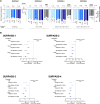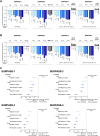Tirzepatide in Hispanic/Latino Patients With Type 2 Diabetes: A Subgroup Analysis of the SURPASS Program
- PMID: 37602701
- PMCID: PMC10795909
- DOI: 10.1210/clinem/dgad495
Tirzepatide in Hispanic/Latino Patients With Type 2 Diabetes: A Subgroup Analysis of the SURPASS Program
Abstract
Context: Efficacy and safety of tirzepatide, a once-weekly glucose-dependent insulinotropic polypeptide and glucagon-like peptide-1 receptor agonist, have been studied in patients with type 2 diabetes in the global phase 3 SURPASS program.
Objective: This work aimed to assess the efficacy and safety of tirzepatide in Hispanic/Latino and non-Hispanic/Latino patients in SURPASS-1 to -4 clinical trials.
Methods: A total of 5679 patients were included, 2895 of self-reported Hispanic/Latino ethnicity, in this exploratory analysis of SURPASS-1 to -4 trial data. Interventions included tirzepatide 5, 10, or 15 mg, placebo, or active comparator (semaglutide 1 mg, insulin degludec, and insulin glargine). Change in glycated hemoglobin A1c (HbA1c) and body weight from baseline to week 40 (SURPASS-1 and -2) and to week 52 (SURPASS-3 and -4), and other efficacy and safety outcomes were evaluated within Hispanic/Latino and non-Hispanic/Latino subgroups.
Results: Among Hispanic/Latino and non-Hispanic/Latino patients treated with tirzepatide, respectively, HbA1c decreased significantly from baseline, ranging from 1.9% to 2.7% and 1.7% to 2.5%, and body weight decreased significantly from baseline, ranging from 5.3 kg to 12.4 and 6.5 kg to 17.1 kg (both P < .05) vs comparators across all trials. Subgroup trends were consistent with the overall trial populations. Treatment-emergent adverse events were reported in similar proportions across the subgroups and were primarily gastrointestinal disorders. The incidence of hypoglycemia was low.
Conclusion: Tirzepatide significatively reduced HbA1c and body weight in Hispanic/Latino and non-Hispanic/Latino patients. Tirzepatide was generally well tolerated in both subgroups. Efficacy and safety trends were comparable between subgroups and within the overall trial populations.
Keywords: GIP and GLP-1 receptor agonist; Hispanic/Latino; glycemic control; incretin therapy; tirzepatide; type 2 diabetes.
© The Author(s) 2023. Published by Oxford University Press on behalf of the Endocrine Society.
Figures


Similar articles
-
Achievement of glycaemic targets with weight loss and without hypoglycaemia in type 2 diabetes with the once-weekly glucose-dependent insulinotropic polypeptide and glucagon-like peptide-1 receptor agonist tirzepatide: A post hoc analysis of the SURPASS-1 to -5 studies.Diabetes Obes Metab. 2023 Apr;25(4):965-974. doi: 10.1111/dom.14943. Epub 2022 Dec 27. Diabetes Obes Metab. 2023. PMID: 36514843 Clinical Trial.
-
Model-based simulation of glycaemic effect and body weight loss when switching from semaglutide or dulaglutide to once weekly tirzepatide.Curr Med Res Opin. 2024 Apr;40(4):567-574. doi: 10.1080/03007995.2024.2322072. Epub 2024 Mar 12. Curr Med Res Opin. 2024. PMID: 38407177
-
Effect of Subcutaneous Tirzepatide vs Placebo Added to Titrated Insulin Glargine on Glycemic Control in Patients With Type 2 Diabetes: The SURPASS-5 Randomized Clinical Trial.JAMA. 2022 Feb 8;327(6):534-545. doi: 10.1001/jama.2022.0078. JAMA. 2022. PMID: 35133415 Free PMC article. Clinical Trial.
-
Tirzepatide, a dual GIP/GLP-1 receptor co-agonist for the treatment of type 2 diabetes with unmatched effectiveness regrading glycaemic control and body weight reduction.Cardiovasc Diabetol. 2022 Sep 1;21(1):169. doi: 10.1186/s12933-022-01604-7. Cardiovasc Diabetol. 2022. PMID: 36050763 Free PMC article. Review.
-
Tirzepatide: A novel, first-in-class, dual GIP/GLP-1 receptor agonist.J Diabetes Complications. 2022 Dec;36(12):108332. doi: 10.1016/j.jdiacomp.2022.108332. Epub 2022 Oct 5. J Diabetes Complications. 2022. PMID: 36375235 Review.
Cited by
-
Tirzepatide 10 and 15 mg versus semaglutide 2.4 mg in people with obesity or overweight with type 2 diabetes: An indirect treatment comparison.Diabetes Obes Metab. 2025 Jul;27(7):3757-3765. doi: 10.1111/dom.16401. Epub 2025 May 5. Diabetes Obes Metab. 2025. PMID: 40321113 Free PMC article. Clinical Trial.
-
Effects of Tirzepatide in Type 2 Diabetes: Individual Variation and Relationship to Cardiometabolic Outcomes.J Am Coll Cardiol. 2025 May 20;85(19):1858-1872. doi: 10.1016/j.jacc.2025.03.516. Epub 2025 Mar 30. J Am Coll Cardiol. 2025. PMID: 40368575
References
-
- Gallardo-Rincon H, Cantoral A, Arrieta A, et al. . Review: type 2 diabetes in Latin America and the Caribbean: regional and country comparison on prevalence, trends, costs and expanded prevention. Prim Care Diabetes. 2021;15(2):352‐359. - PubMed
-
- Mainous AG III, Diaz VA, Koopman RJ, Everett CJ. Quality of care for Hispanic adults with diabetes. Fam Med. 2007;39(5):351‐356. - PubMed
-
- Kirk JK, Passmore LV, Bell RA, et al. . Disparities in A1C levels between Hispanic and non-Hispanic white adults with diabetes: a meta-analysis. Diabetes Care. 2008;31(2):240‐246. - PubMed
MeSH terms
Substances
Grants and funding
LinkOut - more resources
Full Text Sources
Medical

